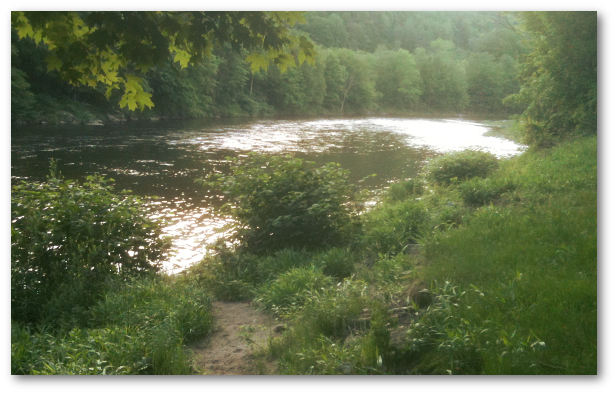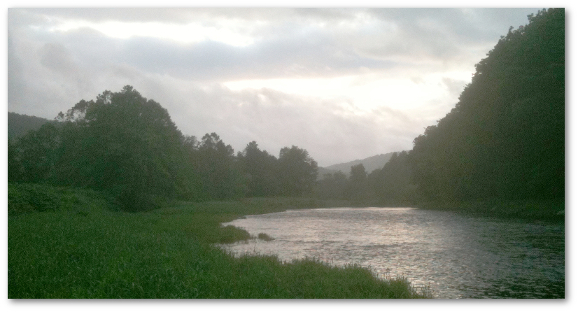|
|
Fly
fishing equipment
A nine-foot rod equipped with a
4 or 5-weight floating line is
most appropriate for the
majority of Catskill rivers. In
the right hands, a 3-weight
outfit can be a nice match on
the freestone rivers, but not on
the tailwaters. Early and late
in the season, as well as during
periods of higher flows, a
6-weight rod may be preferable.
If you had to pick just one tool
for the Catskills, however, a
nine foot rod for 4-weight line
would be the best choice.

Over the
past few years, I have switched
to mostly using furled
monofilament leaders. They cast
beautifully and are more
versatile than their tapered
monofilament counterparts. The
best casting furled leaders I
have found are made by Joni, the
Utah
Flygoddess. I usually
order the six-footer with a
micro swivel at the end.
Breathable chest-high waders are
the gold standard. While you
will only be wading in water
that is two or three feet deep,
most of the time, it is still
advisable to have chest-high
waders. Most can easily be
converted to waist-highs. A
wading belt is always a wise
choice. Felt-soled boots are the
best choice for local rivers.

This is not to suggest that fly
fishers should turn to camo.
They should not! The take away
lesson is to avoid white hats,
tropical colors, and shiny
silver reels.
While the trout don't mind if
you wear jeans and a T-shirt,
you will be much more
comfortable with wicking fleece
under your waders and a
fast-drying, technical shirt.
Leave the jeans and T-shirt in
the car. Whenever wading, it's
always a good idea to have a dry
set of spare clothes just in
case. . .
Additional items
- Polarized
sunglasses (brown lenses)
- Non-DEET
bug repellent (DEET
ruins fly lines and
waders)
- Flashlight
- Compact
waterproof
point-&-shoot camera
- Waterproof
pouch
for your cell phone!
The weather can
change frequently in the
Catskills, and rain usually
creates excellent fishing
conditions. A raincoat or light
shell is standard fare in the
Catskills. Even in the middle of
summer, the evenings can get
chilly. You'll want to bring
along an extra fleece or
"puffy."
Lodging
& Dinning
The lists below are by no means
exhaustive. There are other
places to stay and eat. While I
am not affiliated with any of
these establishments, they all
have a good reputation for
providing reliable and
consistent service.
|
Raimondo's
Pizzeria
Roscoe Diner
Riverside Café
Courtyard
|
Creekside
Cabins
Roscoe Motel
Riverside Cabins
Reynolds House
|
When planning to fish the West
Branch exclusively, you may want
to consider staying in Hancock,
NY instead. The Hancock House is
a fine choice for both lodging
and dining.
Directions
Roscoe (zip code 12776) is
located off exit 94 on NY Rout
17 (future I-86). It is a mere
two hours from the George
Washington Bridge.
When fishing rivers other than
the Beaverkill, such as the East
or West Branches of the
Delaware, the towns of Hancock
and Deposit NY, also along Rt
17, become important locations
of which to be aware. Sometimes
river conditions necessitate
traveling as far as 30 minutes
west of Roscoe.
Hatch
Chart
Some anglers plan their whole
trip around a specific species
of Mayfly. Others just want to
know what's hatching at a given
time of year.
While the chart below is
specific to Mayflies, keep in
mind that there are various
species of caddis, stoneflies,
and midges that hatch throughout
the year. They are a very
significant food source for the
trout and should not be
overlooked.
The hatch chart is being
updated. It will be back soon.
Even though May and June get
most of the attention, the
entire system fishes really well
throughout the whole season. Isonychia,
olives, and various caddis
continue to hatch from summer
through the fall.
September
and October provide outstanding
fishing opportunities. The
largest trout of the season are
usually caught in the autumn. As the trout
are looking to fatten up before
they spawn, streamer fishing
also becomes quite productive.
Autumn in
the Catskills comes without the
crowds, and with the added bonus
of breathtaking northeast fall
foliage.
Weather
Freestone rivers like the
Beaverkill and Willowemoc
primarily rely on rainfall to
maintain flow rates. Tailwaters
such as the East and West Branch
rely mostly on releases from
their respective reservoirs. In
both cases, the weather plays an
important role in river flow and
water temperature. Weather also
dictates insect emergence and
thereby trout feeding activity.
It's all very symbiotic.
During the summer, keep an eye
out for overcast and rainy days.
Those kinds of weather
conditions make for the best
trout fishing. Consider, for
example, that as barometric
pressure drops, the pressure on
the surface of the water also
decreases. Insects must break
through the meniscus in order to
hatch. Insects hatch when
conditions are most favorable to
their survival. The lower air
pressure associated with rain
presents an ideal window of
opportunity for good hatch
activity. This is just one of
several reasons why dreary
weather triggers trout to feed.
About
river flows & water
temperatures
The USGS graphs show realtime
flow rates for specific rivers.
This information is extremely
useful when you know how to
interpret the numbers.
A flow rate of 300 cfs (cubic
feet/second) in one river does
not mean the same thing for
another river. For example, 750
cfs is a great flow rate for
wading the West Branch. But the
same 750 cfs in the Beaverkill
would make the river too high to
fish. So while the amount of
water is the same, what it means
for river conditions varies
depending on the contours of the
river.
The fishability of a river is
determined by balancing flow
rate with water temperature.
Here are some guidelines for
interpreting the USGS data:
The
Beaverkill fishes well between
100 and 500 cfs. While a 100 cfs
flow rate may be fine when the
air temperatures are cool to
moderate, when it's hot, a rate
of 100 cfs (or less) will result
in thermal stress on the trout.
When this happens, it becomes
unethical to fish.
The West Branch fishes well
between 250 and 1000 cfs for
wading purposes. When the river
is above 1100 cfs, a boat
becomes necessary. The same
temperature considerations
apply, although it is usually
less of a concern with
tailwaters. This is because most
of the water is being released
from the bottom a dam.
Trout like water temperatures
between 50 and 65 degrees
Fahrenheit. As water
temperatures near 70, trout
become stressed.
Things
to do besides fishing
No trip is complete without
visiting the Catskill Fly
Fishing Center & Museum
located 15 minutes away in
Livingston Manor, NY. Besides
the CFFCM, Roscoe's Main Street.
is lined with little antique
shops and boutiques.
The Baseball Hall of Fame in
Cooperstown, NY is about one and
a half hours north of Roscoe.
For those looking to get in a
round of golf, there is the
Tennanah Lake Golf Resort.
Related
books of interest
From the history of its people,
and where to catch trout, to how
to tie Catskill style flies,
much has been written about
these fertile rivers. For those
who enjoy fiction, there is even
a murder mystery that takes
place in Roscoe with fly fishing
in the background.
|
|